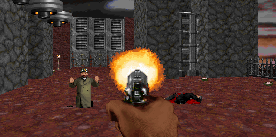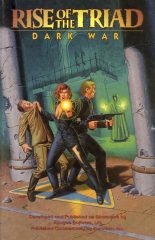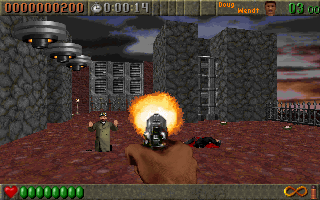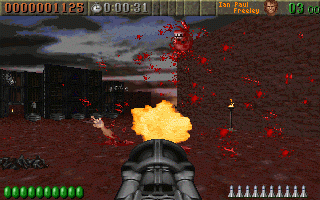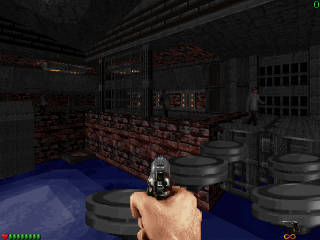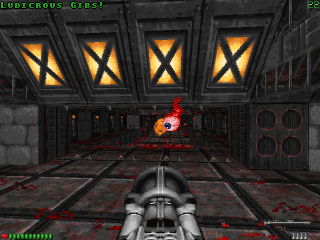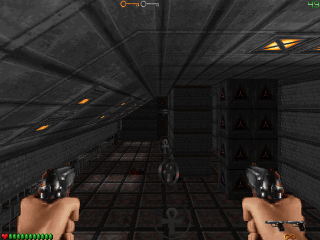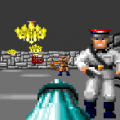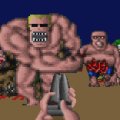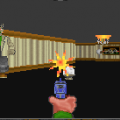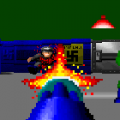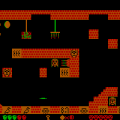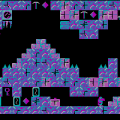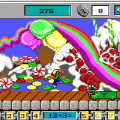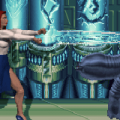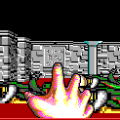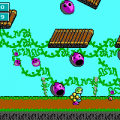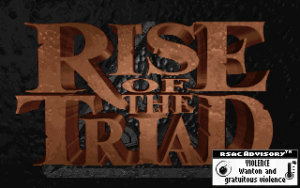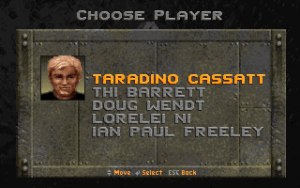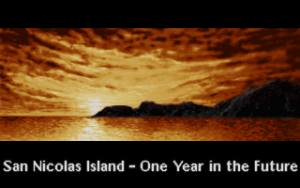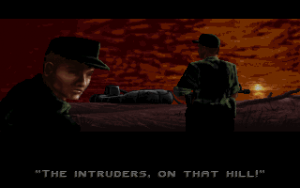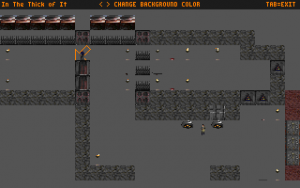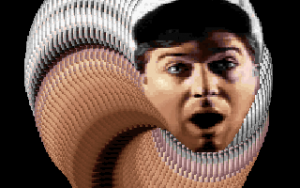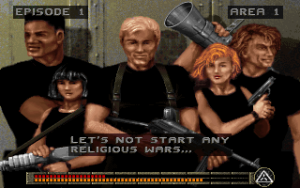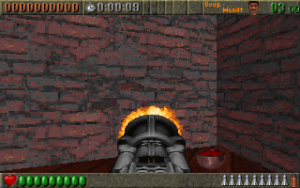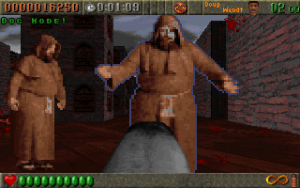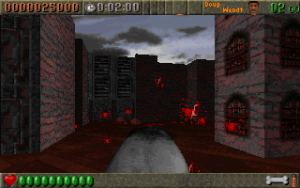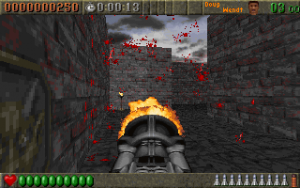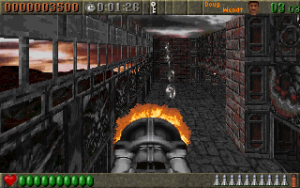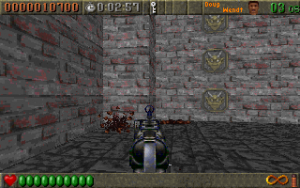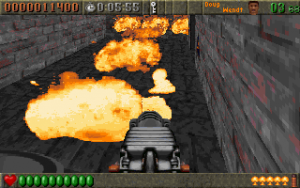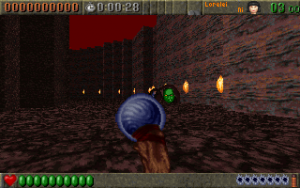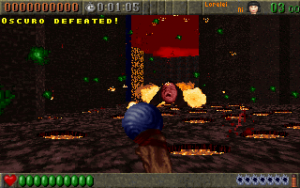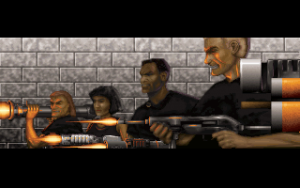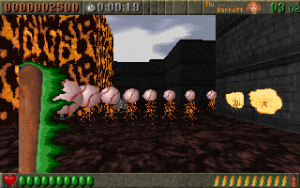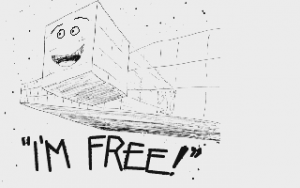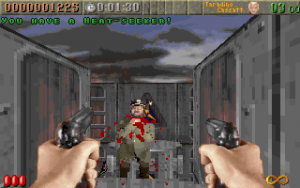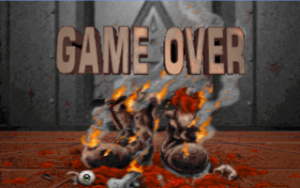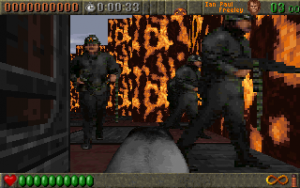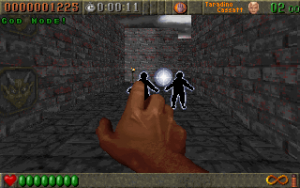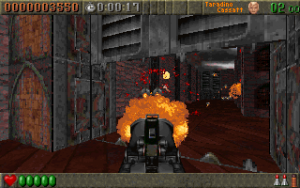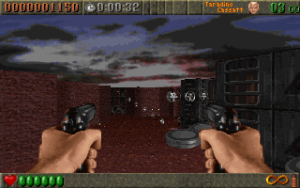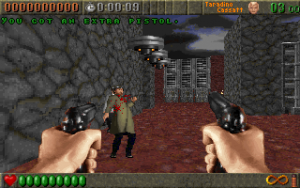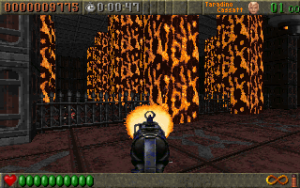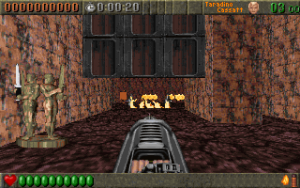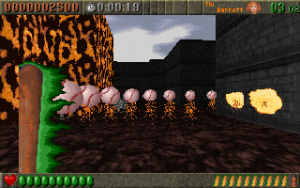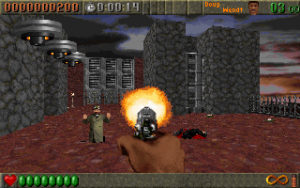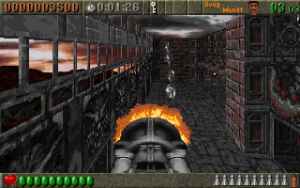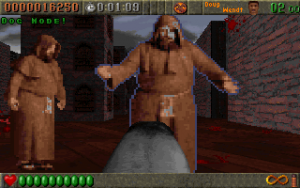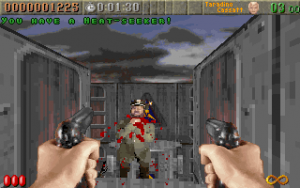- Rise of the Triad
- Rise of the Triad (2013)
In the 1990s, no other genre seemed to dominate the PC gaming market quite like the first person shooter. And you could expect pretty much anybody worth anything in the PC scene to make their own attempt at overthrowing Doom. One such effort came from Apogee, a Texas-based company known for their console-quality action games. It wasn’t their first foray into the world of FPS gaming, since they had previously published iD’s Wolfenstein 3D, along with its spiritual successor, Blake Stone: Aliens of Gold. With an unfathomable number of “Doom clones” out on the market, however, Apogee would soon bring their own twist on the genre. It never did quite receive the love and adoration as Doom or Wolfenstein, but Rise of the Triad (or ROTT) has its own style and cheese that make it worth looking into if you’re a fan of the genre. Also, you can play as a dog.
Interestingly enough, however, Rise of the Triad was originally planned as a sequel to Wolfenstein 3D. The story would have involved BJ Blazkowicz going against an evil organization known as the Triad, who had been secretly behind Hilter’s domination plans the whole time. Over time, the Wolfenstein license would be dropped from the game, but a lot of the ideas from the original design would be reworked into a new, original game. The connections aren’t hard to find, given that ROTT runs off of the Wolf 3D engine, not to mention the fact the enemies you’re blasting look suspiciously Nazi-like.
Sometime in the near future, a cult known as the Triad has plans to destroy Los Angeles. A group of five special operatives known as The HUNT (High-Risk United Nations Task-force) are sent in to investigate the cult’s base of operations on an island off the coast of California. They’re soon quickly discovered, and their boat is blown to pieces. Not having much other choice, the HUNT team proceeds to start shooting every single living thing they can find. With some luck, this may eventually lead to them finding the Triad’s leader, El Oscuro, and killing him. But mostly, it involves shooting things. This being an early FPS, there’s not much focus on the plot, aside from a few still images to start the game and bridge each “episode”. Still, the fact that the game has an introductory cutscene is pretty impressive, considering that Doom didn’t even bother.
Upon starting a new game, you’re given a choice of which of the five different members of The HUNT you want to play as. This actually does have an effect on gameplay, as each characters varies in speed, health, and their accuracy with bullet weapons. For example, Doug Wendt can take a lot more punishment than Loreili Ni, but he’s not fast enough to get to some of the secrets she can reach. If you’re looking for the “Mario” of the group, however, you’d do well to go with Taradino Cassat or Thi Barret, both of which are generally pretty average in stats. Your choice of character doesn’t do anything to effect the story, however, so it generally depends on your playstyle.
You start out with nothing but a single pistol, although you can find a second one for some akimbo action. The MP40 offers the best damage and rate of fire, so once you find it, there’s pretty much no reason to go back to the previous bullet weapons. The bullet weapons won’t do much good on anything besides the weakest minions, but you’re free to spray lead wherever you want without fear of reloading. In an unusual twist from Doom, however, you’ve only got four weapon slots with which to carry your firepower. It’s actually not entirely unlike what modern shooters like Halo end up doing with the way they handle weapon selection.
The first three weapon slots hold your bullet weapons, while the fourth slot holds whatever “special” weapon you’re carrying at the time. Special weapons are much more powerful than your standard bullet weapons, but they only hold so much ammo. Once you use up all the ammo in a special weapon, it’s gone, until you can find another pickup. Don’t worry, though, because this is an FPS, so nobody ever bothers to lock up the several dozen bazookas in a level where some guy won’t just pick them up off of the floor.
And what a selection of special weapons there is. In fact, ROTT‘s weapon selection might just be more plain fun than Doom‘s, just for how crazy some of the weapons can get. On the weaker end of things, you’ve got bazookas and heat-seeking rocket launchers. Or you could go with the Drunk Missile, which shoots out a cluster of missiles with every shot which “waver” around as they fly forward. Even better is the Flamewall, which creates a huge wall of fire that moves forward with each shot, leaving nothing behind of almost any enemy except for a pile of bones. There’s also a couple of magical weapons, including the Excalibat, a magical baseball bat that can fire off a line of exploding baseballs. Along with using it to beat an enemy’s face in, of course.
There’s also a selection of powerups to help you out on your mission. The porridge and gruel you use to restore your health can be heated up with an explosion, increasing its effectiveness. There are also giant Mario-style coins floating around over the place, and In standard console fashion, collecting a hundred of these will give you an extra life. Yes, ROTT uses lives, probably due to the Wolfenstein‘s engines limitations. Keeping a quicksave at the start of every level means you don’t even have to bother with them, however, and the game will even offer to load your last save if you die. Bulletproof vests and asbestos armor provides complete protection against bullets and fire, respectively. In fact, careful use of one of the missile weapons and the asbestos armor can lead to quite possibly the first example of rocket jumping in an FPS.
Some powerups also give your character new abilities, or sometimes, disabilities. Shrooms mode makes the screen waver around constantly, makes enemies glow bright colors, and generally makes things very annoying to shoot. Elasto mode removes all inertia from your character, making him bounce off of the walls. Mercury Mode lets you fly around the level for a limited time, able to reach new heights and rain all sorts of death on your foes below. The best one of all, however, would have to be God Mode. No, not as in the cheat code. As in, a literal god. As a god, you can fire forth an unlimited number of energy balls which vaporize enemies, while you get to listen to John Romero make silly yawning noises for as long as it lasts. (It’s an in-joke between iD and Apogee about the noises he’d make using No-Clip mode in Wolf 3D, apparently.) On the other end, you’ve got Dog Mode, which turns you into an invincible dog, capable of not only tearing enemies to shreds, but also making any nearby foes explode into a bloody mess with a single howl. It’s as stupidly awesome as it sounds.
The variety of enemies you’ll use all this stuff on isn’t quite as varied as Doom‘s, sadly, since you’ll mostly be facing guys in uniforms. You’ve also got a couple of different types of robots to deal with, along with some evil monks. Even the standard guards shouldn’t be entirely underestimated, however, because they can be craftier than you’d think from an era where most AI boiled down to “move forward and shoot”. One type of guard can roll to avoid your shots, while another can fire nets at you that can leave you a sitting target if you don’t have a knife. Oddly enough, however, this is the only point in the game where you can actually use a knife. Then again, who needs a knife when you’re carrying an MP40 that never needs reloading?
One of the more interesting enemies, however, would have to be the Lightning Guard. They’re only a single step up from the Low Guards, the weakest enemy type in the game, but they’ve got a few tricks. For one thing, they can grab that snazzy Heatseeker you’re holding right from your hands and blow you away with it. There’s also a chance they’ll drop to their knees and beg for their lives when they’re near death, giving you the perfect chance to pull out your bazooka and finish them off. Don’t feel too bad about it, because Lightning Guards you spare love to pop back up when you’re not looking and go right back to trying to kill you.
The final level of each episode ends with a boss fight, which usually starts off with you trying to figure out how to actually get to the boss. Unlike Doom‘s bosses, which were generally just enemies that took more shots to kill and did more damage, something about the boss fights in ROTT feels a bit more… special. There’s a song just for boss fights that plays when one spots you, and most of them tend to taunt you a lot with lines like “They’ll bury you in a lunchbox!”. Most of bosses aren’t all that tough, with the exception of Episode 3’s boss, the NME. It looks like a bootleg Dalek, but the thing can move surprisingly fast, and its homing missiles can hit you from just about anywhere in its arena if you don’t take cover from them. Not even El Oscuro is as much of a pain, although he has a rather mean trick in store for you if you aren’t thorough looking through the final level.
It’s not just the enemies that are trying to kill you, either, as there’s traps laying all over the place for you to deal with. Jets of flame can shoot out of the floor, gun emplacements can pop right out of the floor and start shooting you before you can even see them, and certain floor tiles you step on can activate things in the level, releasing enemies or setting off even more traps. Bladed pillars are also pretty common, moving around on a set path. Some of the walls also move around, killing you instantly if you step too close to one. Thankfully, unlike a lot of games, enemies are just as capable of killing themselves with their own traps as you are, and they have no problems walking right into a roaring jet of fire to get to you. There are also holes you can trip and fall in. They’re not even all that deep, but they’ll still cause a little damage to you each time you fall in. Nothing’s quite as humiliating as dying because you tripped and fell.
Much like any classic FPS, most levels in ROTT involve killing enemies, grabbing keys, using those keys to unlock doors, killing more enemies, and finding the exit. The level design is never quite as complex as Doom’s, since even though the game’s working with a heavily modified version of Wolfenstein‘s engine, it’s still Wolfenstein at the core. Everything’s at a 45 degree angle, so there aren’t any slopes or angled walls. There is much more of a vertical element than Wolf had, however, as you can use spring pads to launch yourself into the air. There’s a little bit of trickery involved when it comes to things like staircases and bridges, as they’re all made by floating metal platforms called GADs. You’ll hardly ever see a single level that doesn’t have at least one GAD, and some levels are practically made of them. It’s not the prettiest solution to the rather flat level design, but given what the developers were working with, it’s a creative one. The levels are also surprisingly destructible for the era, as glass can be shot out, scenery like plants and tables can be blown up, and light sources can be destroyed, darkening the level.
The earlier stages are generally more fun than the later episodes, as the further you get into the game, the more cheap shots it tends to throw at you. By the final episode, the game starts to throw monks en masse at you, each one which taking forever to kill with bullet weapons alone. It doesn’t help that the level design just doesn’t stay as fresh as something like Doom, although all the traps help keep things interesting. Frustrating, sure, but still interesting.
One particular feature about the game is just how straight up zany it is compared to Doom, which generally took itself completely seriously. Most of the silliness is easy to find, like the Dog Mode powerups. Some of it is rarer, however, like the random chance that elevators you enter will play some cheesy muzak before switching back to the level’s song. Or the fact that the game’s level select has a level called “This Causes An Error”. As it turns out, they’re really not kidding, as you’ll find out when a moving wall escapes the level’s boundaries. Take a look at this link if you want to see what happens next. Or, if you start the game with “-dopefish'” in the command line, it’ll replace the game’s intro with Apogee employee Scott Miller’s head burping at you while polka plays. Along with giving levels random names like “Hope you wrote your will!” The goofiness even extends to the menus, where you have difficulty levels with names like “I Think I Left The Stove On” and “I’m A Freight Train O’ Death”.
Compared to Doom, ROTT feels a lot more like an arcade game in some ways, especially since the gameplay tends to move at a faster pace than Doom. The game even keeps track of your score, and there are certain bonuses you can get at the end of each level to bring up your score. You can get bonuses for killing all the enemies on the level, finishing a level with only one dot of health left, or destroying every single plant in the level. Sure, score isn’t good for much besides seeing your name on the high score table, but it’s a nice feature.
The graphics are pretty good for the time period, although the game’s simpler level design means it’s not quite as pretty as Doom. The weapons and characters are all digitized, with different employees around the Apogee office taking up roles as enemies. George Broussard takes the role of the Triad Enforcers, for example, so feel free to take your disappointment about Duke Nukem Forever on each and every one of them. The music’s especially good, even in MIDI form, and a lot of the tracks do a great job of matching up with the action. While there’s plenty of slower tracks, some of the game’s best tracks outshine some of even Doom‘s songs. There’s also a particularly rocking version of God Rest Ye Merry Gentlemen in there, too.
The most noteworthy thing about the graphics above all, however, would have to be the gore. Killing enemies with special weapons reduces them to a chunky salsa, and on rare occasions, they’ll make an extra large mess, with the words “LUDICROUS GIBS!” appearing on screen. If you’re big on this effect, there’s a cheat code you can use to make it happen with every kill, just so you can make sure there isn’t an inch of floor not covered in guts and eyeballs. Sometimes you’ll catch an arm flipping you off somewhere in the mess, too.
Besides the standard single player mode, there’s also a very in depth multiplayer mode. With some finagling in DOSBox, it’s perfectly possible to start a match with some friends and blow each other away. Besides your standard deathmatch mode, you’ve got modes like Capture the Triad, possibly the first instance of Capture the Flag in any FPS. There are also modes like Eluder, where you have to chase down Triad symbols for points, or Deluder, where you have to blow up the symbols instead to score. There’s ten different multiplayer modes in total, way more than even Doom would ever offer. Each mode can also be customized with options like the level of gravity, the speed and health of the players, and even the option to spawn mines instead of health pickups, among other things.
So why was ROTT never quite as well regarded as Doom? It could be that the engine was just too low-tech compared to the things iD was pulling with their engines. It could be that it just got lost in a sea of inferior shooters released around the same time. But although it never quite reached the insane heights of popularity as Doom, it still ended up as quite the cult classic. It’s not quite as pretty as Doom, nor is it as well designed in its gameplay and its engine. Still, for all its issues, it can be an incredibly fun game.
Some of the ideas in ROTT would eventually reused in Duke Nukem 3D, like the amount of destruction you could cause, loads of gibs, and just a pinch of humor to contrast with Duke’s rather dark setting. Sadly, however, the team behind the game, who referred to themselves as “The Developers of Incredible Power”, never made another game. They were behind the earliest versions of Prey, back in 1996, before it would become something very, very different about a decade later, but nothing that would end up released.
There are a few variations of the game out there, mostly differing in level selection. The HUNT Begins is the shareware version of the game, which comes with a set of unique levels that don’t appear in the full version. There’s also a “Deluxe Edition” of the shareware episode floating around, which comes with a few extra levels of its own. Extreme Rise of the Triad is basically a set a new of levels for the game, complete with an excuse plot where El Oscuro reverses time after his defeat so the HUNT has to kill him all over again. It doesn’t come with any new enemies or weapons, so it’s only worth looking into if you really enjoyed the original game. All of these level sets are available from 3D Realm’s websites, including a few extra goodies like .WAV files, fan levels, and level editors, among other things.
The game’s pretty easy to pick up and play no matter what version you’re looking for. You can also buy the port released for iOS devices from the App Store, but considering how well FPSes usually play on a touch screen, maybe not. Aside from that, though, it seems to be a faithful port.
Links:
3D Realms Official Website – ROTT Includes plenty of downloads.
The Hunt: Rise of the Triad An excellent fan site that was on Classicgaming, now archived on Kontek.
Good Old GamesYou can buy the full version of the game here for only $6.
Return of the Triad – Windows (2006)
Return of the Triad is more of a fangame than anything, sort of a big homage to the original ROTT. A group of dedicated fans took ZDoom, a source port for the Doom engine that includes a lot of extra features and capabilities, and made a spiritual sequel. Due to some of ZDoom’s limits, it’s not a complete match for the original ROTT’s gameplay. There’s a few minor issues, such as every character sounding like just Taradino Cassat, or the fact that horizontal GADs can’t be done on the ZDoom engine. But, considering that’s a free game that doesn’t even require the cost of Doom 2, that’s easily forgivable.
The only real original content in Return are the levels, since all the enemies and weapons have been brought over entirely from the original game. You’re also no longer restricted to carrying one special weapon at the time, and you’re free to switch between any of them you might be carrying line in Doom. It’s an odd change, but one that works for the better at times. Especially since you won’t have to hunt down another bazooka if you run out while fighting a horde of enemies. Another nice change is that you no longer have limited lives. The Mario-style ankh coins remain, but picking up a hundred this time around gives you full health and God Mode.
The biggest improvement that the ZDoom engine offers is that the levels are much more complex when it comes to architecture than the original ROTT. There are stairs, slopes, bridges indoor and outdoor areas, and other such features that help make the levels look a little less flat and blocky. Not that still look anywhere like an actual place, but it’s still quite the visual improvement. Other than that, it’s basically just more Rise of the Triad, which is hardly a bad thing.
Links:
ModDB The mod’s avaiable for download here.
